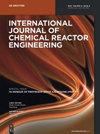Macroscopic analysis of chemical looping combustion with ilmenite versus conventional oxides as oxygen carriers
IF 1.6
4区 工程技术
Q3 Chemical Engineering
International Journal of Chemical Reactor Engineering
Pub Date : 2023-01-26
DOI:10.1515/ijcre-2022-0108
引用次数: 0
Abstract
Abstract Over 40% of global energy-related CO2 emissions are due to the combustion of fossil fuels for electric energy generation. Albeit CO2 capture and storage have been identified as promissory actions to mitigate its emissions, the problem separating N2 and CO2 remains. A very effective solution for the former problem is to obtain the combustion CO2 as a pure molecule, which is possible using the Chemical Looping Combustion (CLC) technology, which uses a solid oxygen carrier to transport the oxygen from an oxidating media (regeneration reactor) to a reducing media (combustion reactor). One of the key issues to apply CLC is to find or develop some material, suitable from the kinetic and thermodynamic points of view, for the reduction-oxidation cycles taking place inside combustion and regenerator reactors. The evaluation of “oxygen carrier” candidates for CLC is based on reactivity (rates and conversions), resistance to carbon accumulation, and “regenerability”, which means the ability of the material for cyclic reduction and oxidation. Another challenging issue to use CLC processes is the loss of oxygen carrier; this problem involves the use of supported metals on materials, such as zirconia, Al2O3, etc. Preparation of this kind of supported carriers requires time, money, and equipment. Meanwhile, the natural mineral ore named ilmenite, which consists of a mixture of iron and titanium oxides, and do not need to be supported, has been seen as promising to increase CLC efficiency as oxygen carrier. In this work, the performance of ilmenite is compared with some other oxygen carriers used in CLC.钛铁矿与常规氧化物作为氧载体的化学环燃烧的宏观分析
超过40%的全球能源相关二氧化碳排放是由于燃烧化石燃料发电。尽管二氧化碳的捕获和储存已被确定为减少其排放的有望行动,但分离N2和CO2的问题仍然存在。对于前一个问题,一个非常有效的解决方案是获得燃烧CO2作为纯分子,这可以使用化学循环燃烧(CLC)技术,该技术使用固体氧载体将氧气从氧化介质(再生反应器)输送到还原介质(燃烧反应器)。应用CLC的关键问题之一是寻找或开发一些从动力学和热力学角度适合于在燃烧和再生反应器内进行还原-氧化循环的材料。对CLC候选“氧载体”的评价是基于反应性(速率和转化率)、抗碳积累和“可再生性”,即材料的循环还原和氧化能力。使用CLC过程的另一个挑战问题是氧载体的损失;这个问题涉及到在材料上使用支撑金属,如氧化锆、氧化铝等。准备这种支持载体需要时间、金钱和设备。同时,一种名为钛铁矿的天然矿物,由铁和钛的氧化物混合而成,不需要载体,被认为是有希望提高CLC效率的氧载体。本文对钛铁矿的性能与其它氧载体进行了比较。
本文章由计算机程序翻译,如有差异,请以英文原文为准。
求助全文
约1分钟内获得全文
求助全文
来源期刊
CiteScore
2.80
自引率
12.50%
发文量
107
审稿时长
3 months
期刊介绍:
The International Journal of Chemical Reactor Engineering covers the broad fields of theoretical and applied reactor engineering. The IJCRE covers topics drawn from the substantial areas of overlap between catalysis, reaction and reactor engineering. The journal is presently edited by Hugo de Lasa and Charles Xu, counting with an impressive list of Editorial Board leading specialists in chemical reactor engineering. Authors include notable international professors and R&D industry leaders.

 求助内容:
求助内容: 应助结果提醒方式:
应助结果提醒方式:


